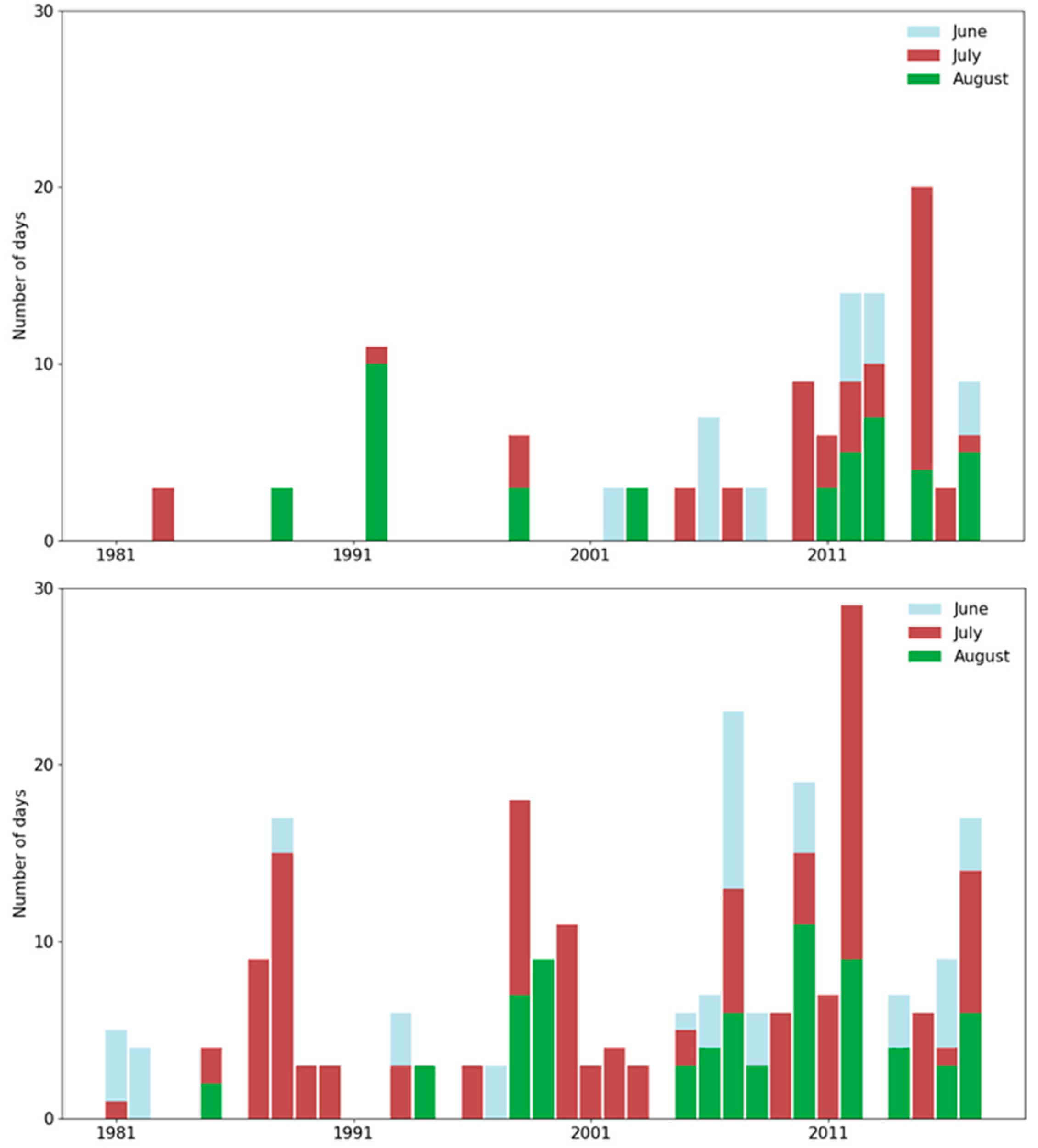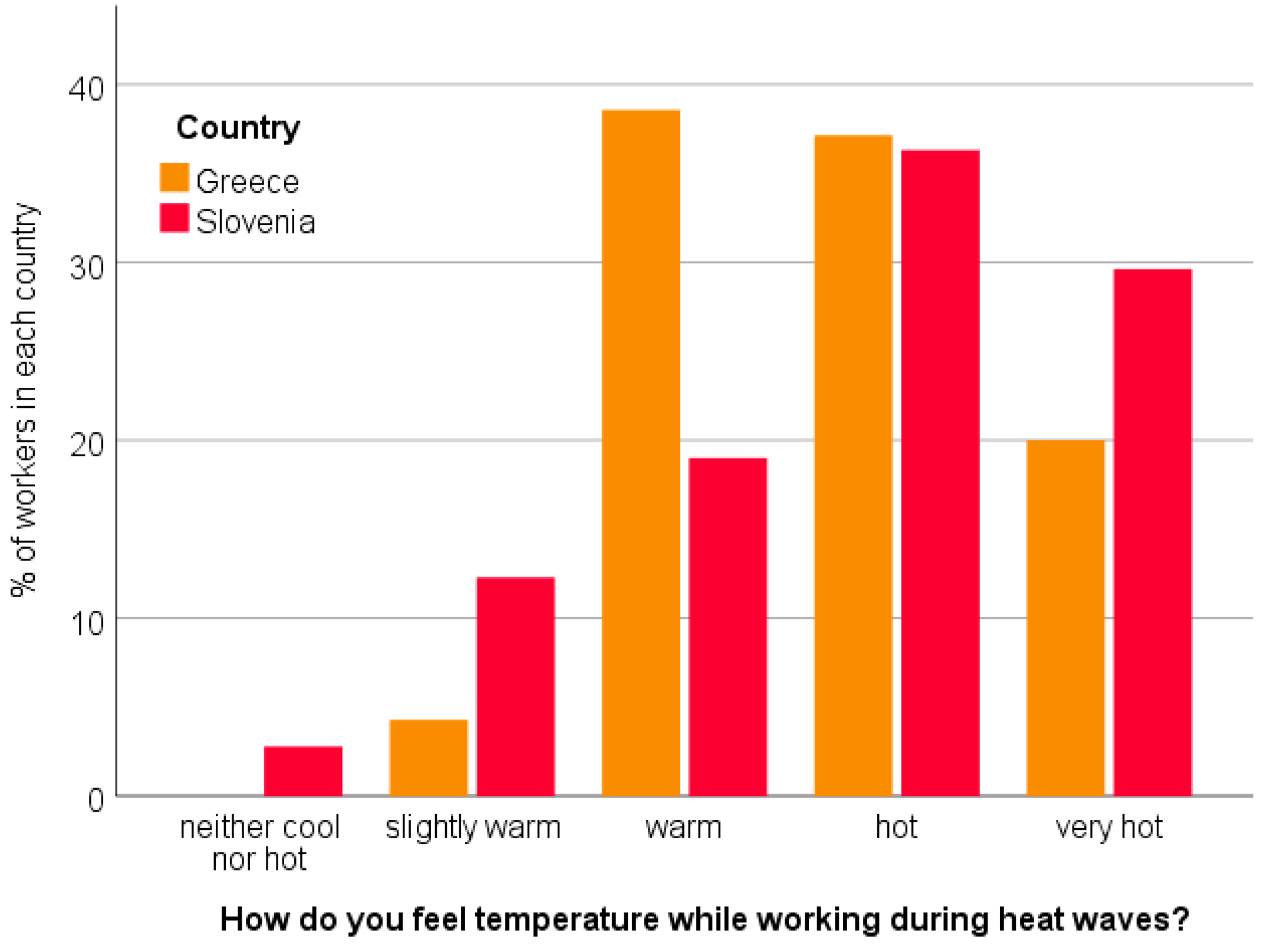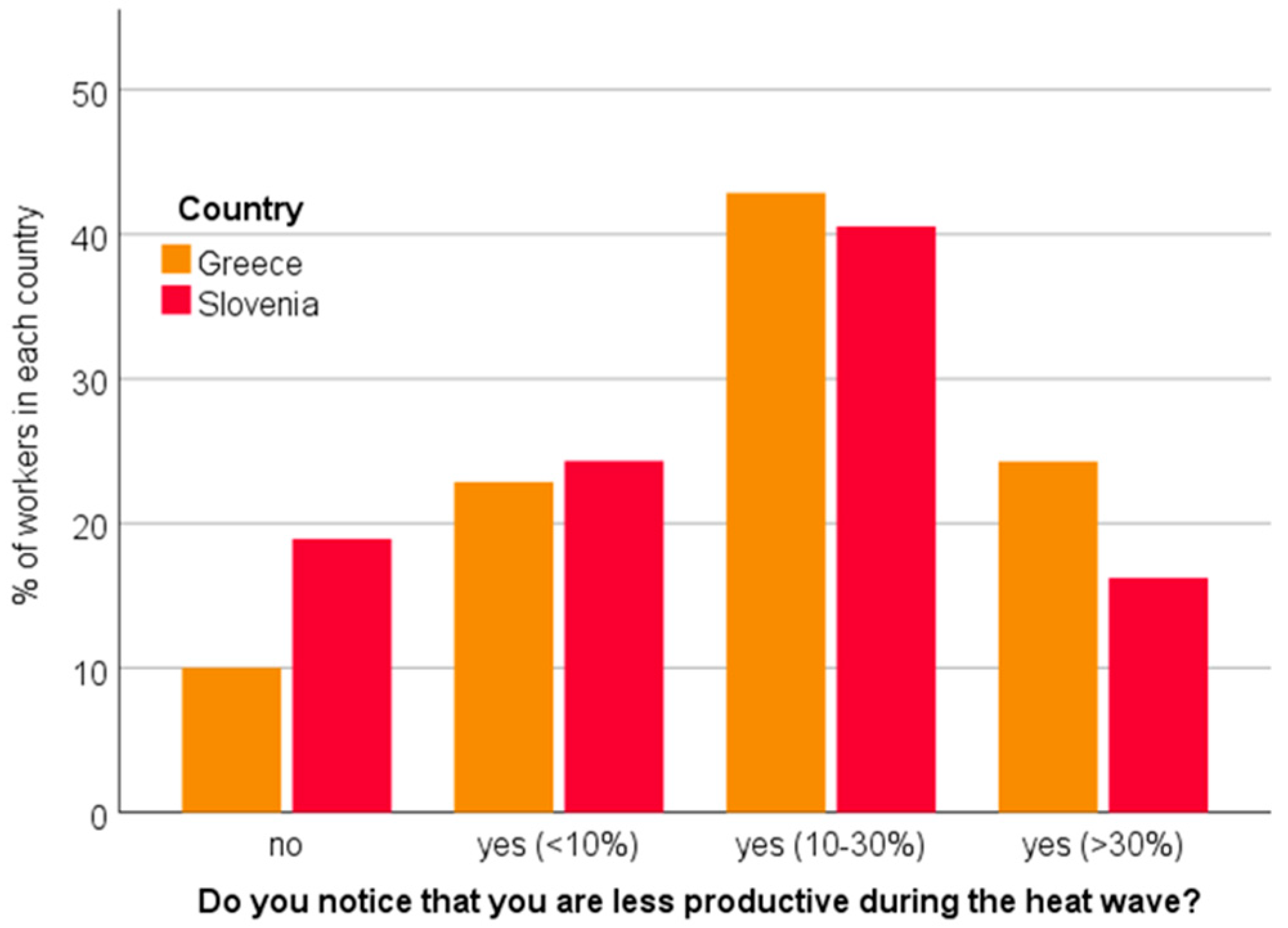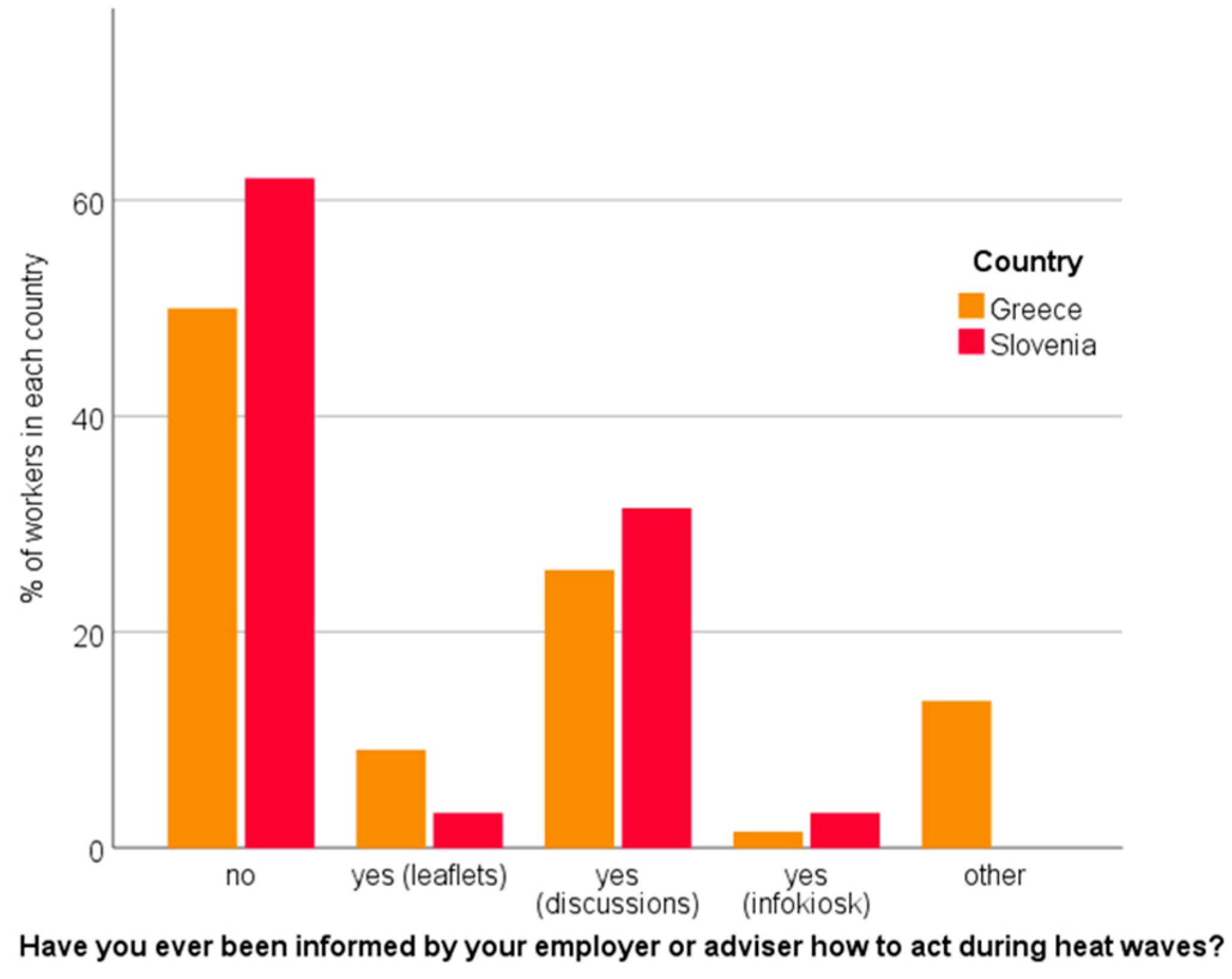Heat Waves Occurrence and Outdoor Workers’ Self-assessment of Heat Stress in Slovenia and Greece
Abstract
:1. Introduction
2. Materials and Methods
2.1. Heat Wave Climatology
2.2. Workers’ Perception of Heat Stress
3. Results
3.1. Comparison of Heat Waves in Slovenia and Greece
3.2. Worker’s Self-Assessment of Heat Stress Impacts
4. Discussion
5. Conclusions
Author Contributions
Funding
Acknowledgments
Conflicts of Interest
References
- Lau, N.C.; Nath, M.J. A Model Study of Heat Waves over North America: Meteorological Aspects and Projections for the Twenty-First Century. J. Clim. 2012, 25, 4761–4784. [Google Scholar] [CrossRef]
- Meehl, G.A.; Tebaldi, C. More Intense, More Frequent, and Longer Lasting Heat Waves in the 21st Century. Science 2004, 305, 994–997. [Google Scholar] [CrossRef] [PubMed] [Green Version]
- Bittner, M.I.; Matthies, E.F.; Dalbokova, D.; Menne, B. Are European countries prepared for the next big heat-wave? Eur. J. Public Health 2013, 24, 615–619. [Google Scholar] [CrossRef] [PubMed] [Green Version]
- Russo, S.; Sillman, J.; Fischer, E.M. Top ten European heatwaves since 1950 and their occurrence in the coming decades. Environ. Res. Lett. 2015, 10, 124003. [Google Scholar] [CrossRef] [Green Version]
- Pereira, S.C.; Marta-Almeida, M.; Carvalhocand, A.C.; Rocha, A. Heat wave and cold spell changes in Iberia for a future climate scenario. Int. J. Climatol. 2017, 37, 5192–5205. [Google Scholar] [CrossRef]
- WMO; WHO. Heatwaves and Health: Guidance on Warning-System Development; McGregor, G.R., Bessemoulin, P., Ebi, K., Menne, B., Eds.; World Meteorological Organization (WMO): Geneva, Schwitzerland, 2015; p. 96. ISBN 978-92-63-11142-5. [Google Scholar]
- IPCC. Managing the Risks of Extreme Events and Disasters to Advance Climate Change Adaptation; Field, C.B., Barros, V., Stocker, T.F., Qin, D., Dokken, D.J., Ebi, K.L., Mastrandrea, M.D., Eds.; A Special Report of Working Groups I and II of the Intergovernmental Panel on Climate Change; Cambridge University Press: Cambridge, UK; New York, NY, USA, 2012; p. 582, ISBN 978-1-107-02506-6 Hardback, ISBN 978-1-107-60780-4 Paperback. [Google Scholar]
- Watts, N.; Amann, M.; Ayeb-Karlsson, S.; Belesova, K.; Bouley, T.; Boykoff, M.; Byass, P. Countdown on health and climate change: From 25 years of inaction to a global transformation for public health. Lancet 2017, 391, 581–630. [Google Scholar] [CrossRef]
- Bouchama, A.; Knochel, J.P. Heat stroke. N. Engl. J. Med. 2002, 346, 1978–1988. [Google Scholar] [CrossRef]
- Parsons, K. Human Thermal Environments. The Effects of Hot, Moderate and Cold Temperatures on Human Health, Comfort and Performance, 3rd ed.; CRC Press; Taylor & Francis Group: London, UK, 2012; ISBN-10 146659599X, ISBN-13 978-1466595996. [Google Scholar]
- Nybo, L.; Kjellstrom, T.; Flouris, A.D.; Kajfež Bogataj, L. Global heating: Attention is not enough; we need acute and appropriate actions. Temperature 2017, 4, 199–201. [Google Scholar] [CrossRef]
- Gao, C.; Kuklane, K.; Östergren, P.O.; Kjellstrom, T. Occupational heat stress assessment and protective strategies in the context of climate change. Int. J. Biometeorol. 2017, 62, 359–371. [Google Scholar] [CrossRef]
- Pascal, M.; Wagner, V.; Le Tertre, A.; Laaidi, K.; Honoré, C.; Bénichou, F.; Beaudeau, P. Definition of temperature thresholds: The example of the French heat wave warning system. Int. J. Biometeorol. 2013, 57, 21–29. [Google Scholar] [CrossRef]
- Lowe, D.; Ebi, K.L.; Forsberg, B. Heatwave Early Warning Systems and Adaptation Advice to Reduce Human Health Consequences of Heatwaves. Int. J. Environ. Res. Public Health 2011, 8, 4623–4648. [Google Scholar] [CrossRef] [PubMed] [Green Version]
- Flouris, A.D.; Dinas, P.C.; Ioannou, L.G.; Nybo, L.; Havenith, G.; Kenny, G.P.; Kjellstrom, T. Workers’ health and productivity under occupational heat strain: A systematic review and meta-analysis. Lancet Planet Health 2018, 2, 521–531. [Google Scholar] [CrossRef]
- Bethel, J.W.; Harger, R. Heat-Related Illness among Oregon Farmworkers. Int. J. Environ. Res. Public Health 2014, 11, 9273–9285. [Google Scholar] [CrossRef] [PubMed] [Green Version]
- Ioannou, L.G.; Tsoutsoubi, L.; Samoutis, G.; Kajfez Bogataj, L.; Kenny, G.P.; Nybo, L.; Kjellstrom, T.; Flouris, A.D. Time-motion analysis as a novel approach for evaluating the impact of environmental heat exposure on labor loss in agriculture workers. Temperature 2017, 4, 330–340. [Google Scholar] [CrossRef] [PubMed] [Green Version]
- Pogačar, T.; Črepinšek, Z.; Kajfež Bogataj, L.; Nybo, L. Comprehension of climatic and occupational heat stress amongst agricultural advisers and workers in Slovenia. Acta Agriculturae Slovenica 2017, 109, 545–554. [Google Scholar] [CrossRef] [Green Version]
- Yi, W.; Chan, A.P.C. Effects of Heat Stress on Construction Labor Productivity in Hong Kong: A Case Study of Rebar Workers. Int. J. Environ. Res. Public Health 2017, 14, 1055. [Google Scholar] [CrossRef] [PubMed]
- Pogačar, T.; Casanueva, A.; Kozjek, K.; Ciuha, U.; Mekjavić, I.B.; Kajfež Bogataj, L.; Črepinšek, Z. The effect of hot days on occupational heat stress in the manufacturing industry: Implications for workers’ well-being and productivity. Int. J. Biometeorol. 2018, 62, 1251–1264. [Google Scholar] [CrossRef] [PubMed]
- Hunt, B.G. A Climatology of Heat Waves from a Multimillennial Simulation. J. Clim. 2007, 20, 3802–3821. [Google Scholar] [CrossRef]
- ECA&D project. Available online: https://www.ecad.eu/ (accessed on 18 October 2017).
- SMD (Slovenian Meteorological Society). Available online: http://www.smd.v-izdelavi.si/data/upload/vrocinski_val(1).pdf (accessed on 11 October 2017).
- Kysely, J. Recent severe heat waves in central Europe: How to view them in a long-term prospect? Int. J. Climatol. 2010, 30, 89–109. [Google Scholar] [CrossRef]
- HEAT-SHIELD Project. Available online: https://www.heat-shield.eu/ (accessed on 23 January 2019).
- Kjellstrom, T.; Odland, J.O.; Nilsson, M. Progress in the Hothaps program assessing impacts and prevention of heat effects on working people in relation to local climate change. Asia Pacific Newslett. Occup. Heal Saf. 2011, 18, 24–25. [Google Scholar]
- De Boeck, H.J.; Dreesen, F.E.; Janssens, I.A.; Nijs, I. Climatic characteristics of heat waves and their simulation in plant experiments. Glob. Change Biol. 2010, 16, 1992–2000. [Google Scholar] [CrossRef]
- Kuglitsch, F.G.; Toreti, A.; Xoplaki, E.; Della-Marta, P.M.; Zerefos, C.S.; Türkeş, M.; Luterbacher, J. Heat wave changes in the eastern Mediterranean since 1960. Geophys. Res. Lett. 2010, 37, L04802. [Google Scholar] [CrossRef]
- Kjellstrom, T.; Freyberg, C.; Lemke, B.; Otto, M.; Briggs, D. Estimating population heat exposure and impacts on working people in conjunction with climate change. Int. J. Biometeorol. 2017, 62, 291–306. [Google Scholar] [CrossRef] [PubMed]
- Flouris, A.D.; McGinn, R.; Poirier, M.P.; Louie, J.C.; Ioannou, L.G.; Tsoutsoubi, L.; Sigal, R.J.; Boulay, P.; Hardcastle, S.G.; Kenny, G.P. Screening criteria for increased susceptibility to heat stress during work or leisure in hot environments in healthy individuals aged 31–70 years. Temperature 2017, 5, 86–99. [Google Scholar] [CrossRef] [PubMed]
- Luther, M.; Gardiner, F.W.; Hansen, C.; Caldicott, D. Hot of Not: Physiological versus Meteorological Heatwaves–Support for a Mean Temperature Threshold. Int. J. Environ. Res. Public Health 2016, 13, 753. [Google Scholar] [CrossRef]
- McInnes, J.A.; Akram, M.; MacFarlane, E.M.; Keegel, T.; Sim, M.R.; Smith, P. Association between high ambient temperature and acute work-related injury: A case-crossover analysis using workers’ compensation claims data. Scand. J. Work Environ. Health 2017, 43, 86–94. [Google Scholar] [CrossRef] [PubMed]
- Van Loenhout, J.A.F.; Guha-Sapir, D. How resilient is the general population to heatwaves? A knowledge survey from the ENHANCE project in Brussels and Amsterdam. BMC Res. Notes 2016, 9, 499. [Google Scholar] [CrossRef]
- Piil, J.F.; Lundbye-Jensen, J.; Christiansen, L.; Ioannou, L.; Tsoutsoubi, L.; Dallas, C.N.; Mantzios, K.; Flouris, A.D.; Nybo, L. High prevalence of hypohydration in occupations with heat stress—Perspectives for performance in combined cognitive and motor tasks. PLoS ONE 2018, 13, e0205321. [Google Scholar] [CrossRef]
- Eckardt, K.U.; Coresh, J.; Devuyst, O.; Johnson, R.J.; Köttgen, A.; Levey, A.S.; Levin, A. Evolving importance of kidney disease: From subspecialty to global health burden. Lancet 2013, 382, 158–169. [Google Scholar] [CrossRef]
- Waikar, S.S.; Curhan, G.C.; Wald, R.; McCarthy, E.P.; Chertow, G.M. Declining mortality in patients with acute renal failure, 1988 to 2002. J. Am. Soc. Nephrol. 2006, 17, 1143–1150. [Google Scholar] [CrossRef]
- Xue, J.L.; Daniels, F.; Star, R.A.; Kimmel, P.L.; Eggers, P.W.; Molitoris, B.A.; Himmelfarb, J.; Collins, A.J. Incidence and mortality of acute renal failure in Medicare beneficiaries, 1992 to 2001. J. Am. Soc. Nephrol. 2006, 17, 1135–1142. [Google Scholar] [CrossRef] [PubMed]
- Krishnamurthy, S.; Mondal, N.; Narayanan, P.; Biswal, N.; Srinivasan, S.; Soundravally, R. Incidence and etiology of acute kidney injury in southern India. Indian J. Pediatr. 2013, 80, 183–189. [Google Scholar] [CrossRef] [PubMed]
- Naicker, S.; Aboud, O.; Gharbi, M.B. Epidemiology of acute kidney injury in Africa. Semin. Nephrol. 2008, 28, 348–353. [Google Scholar] [CrossRef] [PubMed]
- Lameire, N.H.; Bagga, A.; Cruz, D.; De Maeseneer, J.; Endre, Z.; Kellum, J.A.; Liu, K.D.; Mehta, R.L.; Pannu, N.; Van Biesen, W.; et al. Acute kidney injury: An increasing global concern. Lancet 2013, 382, 170–179. [Google Scholar] [CrossRef]






| Greece (n = 70) | Slovenia (n = 216) | |
|---|---|---|
| Gender | ||
| Male | 77.1% | 57.4% |
| Female | 22.9% | 42.6% |
| Age | ||
| 20–30 | 20.0% | 14.8% |
| 31–40 | 44.3% | 30.6% |
| 41–50 | 10.0% | 23.1% |
| 51–60 | 15.7% | 22.2% |
| 61 and more | 10.0% | 9.3% |
| Education level | ||
| Primary school or none | 20.0% | 5.6% |
| Secondary school | 21.4% | 43.5% |
| College | 25.7% | 26.4% |
| Bachelor’s degree | 24.3% | 21.3% |
| Master’s degree/PhD | 8.6% | 3.2% |
| Working outdoors | ||
| one–two thirds | 44.3% | 50.9% |
| two–three thirds | 55.7% | 49.1% |
| Chronic disease | ||
| Yes | 15.7% | 30.6% |
| No | 84.3% | 69.4% |
| Greece (n = 70) | Slovenia (n = 216) | p-Value | |
|---|---|---|---|
| Heat stress impact is negligible | |||
| Yes | 7.1% | 6.0% | 0.763 |
| No | 92.9% | 94.0% | |
| Heat stress has a significant impact on well-being | |||
| Yes | 60.0% | 74.1% | 0.025 * |
| No | 40.0% | 25.9% | |
| Heat stress has a significant impact on concentration | |||
| Yes | 25.7% | 38.0% | 0.062 |
| No | 74.3% | 62.0% | |
| Heat stress has a significant impact on productivity | |||
| Yes | 68.6% | 71.3% | 0.664 |
| No | 31.4% | 28.7% | |
| Experienced heat stress symptoms | |||
| None | 2.9% | 0.0% | 0.013 * |
| Thirst | 70.0% | 82.4% | 0.026 * |
| Tiredness | 51.4% | 62.0% | 0.116 |
| Dizziness | 18.6% | 24.1% | 0.340 |
| Confusion | 15.7% | 10.6% | 0.255 |
| Enhanced stress | 12.9% | 25.9% | 0.023 * |
| Excessive sweating | 67.1% | 84.7% | 0.010 * |
| Experienced heat induced diseases | |||
| Headache | 44.3% | 52.8% | 0.217 |
| Exhaustion | 51.4% | 62.0% | 0.116 |
| Prickly heat | 5.7% | 13.0% | 0.095 |
| Muscle cramps | 7.1% | 6.0% | 0.736 |
| Fainting | 4.3% | 8.3% | 0.259 |
| Nausea/vomiting | 5.7% | 13.9% | 0.066 |
| Heat cramps | 4.3% | 0.5% | 0.018 * |
| Heat stroke | 5.7% | 0.0% | <0.001 * |
| None | 22.9% | 15.3% | 0.144 |
| Hospitalization due to heat stress | |||
| No | 94.3% | 92.6% | 0.629 |
| Yes | 5.7% | 7.4% | |
| Can you reduce your exposure to heat stress | |||
| No | 24.3% | 12.5% | 0.018 * |
| Yes | 75.7% | 87.5% | |
| How can you reduce your exposure to heat stress | |||
| Increase the number of breaks during the work | 20.0% | 32.9% | 0.041 * |
| Retreat to cooler space during breaks | 41.4% | 54.2% | 0.064 |
| Wear appropriate clothes | 40.0% | 49.1% | 0.186 |
| Drink more water | 64.3% | 82.4% | 0.001 * |
| Adjust working schedule | 34.3% | 65.7% | <0.001 * |
© 2019 by the authors. Licensee MDPI, Basel, Switzerland. This article is an open access article distributed under the terms and conditions of the Creative Commons Attribution (CC BY) license (http://creativecommons.org/licenses/by/4.0/).
Share and Cite
Pogačar, T.; Žnidaršič, Z.; Kajfež Bogataj, L.; Flouris, A.D.; Poulianiti, K.; Črepinšek, Z. Heat Waves Occurrence and Outdoor Workers’ Self-assessment of Heat Stress in Slovenia and Greece. Int. J. Environ. Res. Public Health 2019, 16, 597. https://0-doi-org.brum.beds.ac.uk/10.3390/ijerph16040597
Pogačar T, Žnidaršič Z, Kajfež Bogataj L, Flouris AD, Poulianiti K, Črepinšek Z. Heat Waves Occurrence and Outdoor Workers’ Self-assessment of Heat Stress in Slovenia and Greece. International Journal of Environmental Research and Public Health. 2019; 16(4):597. https://0-doi-org.brum.beds.ac.uk/10.3390/ijerph16040597
Chicago/Turabian StylePogačar, Tjaša, Zala Žnidaršič, Lučka Kajfež Bogataj, Andreas D. Flouris, Konstantina Poulianiti, and Zalika Črepinšek. 2019. "Heat Waves Occurrence and Outdoor Workers’ Self-assessment of Heat Stress in Slovenia and Greece" International Journal of Environmental Research and Public Health 16, no. 4: 597. https://0-doi-org.brum.beds.ac.uk/10.3390/ijerph16040597





